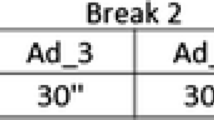Abstract
The aim of this research is to analyze the changes in the EEG frontal activity during the observation of commercial videoclips. In particular, we aimed to investigate the existence of EEG frontal asymmetries in the distribution of the signals’ power spectra related to experienced pleasantness of the video, as explicitly rated by the eleven experimental subjects investigated. In the analyzed population, maps of Power spectral density (PSD) showed an asymmetrical increase of theta and alpha activity related to the observation of pleasant (unpleasant) advertisements in the left (right) hemisphere. A correlation analysis revealed that the increase of PSD at left frontal sites is negatively correlated with the degree of pleasantness perceived. Conversely, the de-synchronization of left alpha frontal activity is positively correlated with judgments of high pleasantness. Moreover, our data presented an increase of PSD related to the observation of unpleasant commercials, which resulted higher with respect to the one elicited by pleasant advertisements.


Similar content being viewed by others
References
Astolfi L, Cincotti F, Mattia D, Marciani MG, Baccalà LA, de Vico Fallani F, Salinari S, Ursino M, Zavaglia M, Babiloni F (2006) Assessing cortical functional connectivity by partial directed coherence: simulations and application to real data. IEEE Trans Biomed Eng 53(9):1802–1812
Astolfi L, Cincotti F, Mattia D, De Vico Fallani F, Tocci A, Colosimo A, Salinari S, Marciani MG, Hesse W, Witte H, Ursino M, Zavaglia M, Babiloni F (2008) Tracking the time-varying cortical connectivity patterns by adaptive multivariate estimators. IEEE Trans Biomed Eng 55(3):902–913
Babiloni C, Carducci F, Del Gratta C, Demartin M, Romani GL, Babiloni F, Rossini PM (2003) Hemispherical asymmetry in human SMA during voluntary simple unilateral movements. An fMRI study. Cortex 39(2):293–305
Babiloni C, Brancucci A, Babiloni F, Capotosto P, Carducci F, Cincotti F, Arendt-Nielsen L, Chen AC, Rossini PM (2003) Anticipatory cortical responses during the expectancy of a predictable painful stimulation. A high-resolution electroencephalography study. Eur J Neurosci 18(6):1692–1700
Babiloni C, Babiloni F, Carducci F, Cappa SF, Cincotti F, Del Percio C, Miniussi C, Moretti DV, Rossi S, Sosta K, Rossini PM (2004) Human cortical responses during one-bit short-term memory. A high-resolution EEG study on delayed choice reaction time tasks. Clin Neurophysiol 115(1):161–170
Braeutigam S, Rose SP, Swithenby SJ, Ambler T (2004) The distributed neuronal systems supporting choice-making in real-life situations: differences between men and women when choosing groceries detected using magnetoencephalography. Eur J Neurosci 20(1):293–302
Coan JA, Schaefer HS, Davidson RJ (2006) Lending a hand: social regulation of the neural response to threat. Psychol Sci 17(12):1032–1039
Davidson RJ (2000) Affective style, psychopathology, and resilience: brain mechanisms and plasticity. Am Psychol 55:1196–11214
Davidson RJ (2002) Anxiety and affective style: role of prefrontal cortex and amygdala. Biol Psychiatry 51(1):68–80
Davidson RJ (2004) What does the prefrontal cortex “do” in affect: perspectives on frontal EEG asymmetry research. Biol Psychol 67(1–2):219–233
Davidson RJ, Irwin W (1999) The functional neuroanatomy of emotion and affective style. Trends Cogn Sci 3:11–21
De Vico Fallani F, Astolfi L, Cincotti F, Mattia D, Tocci A, Marciani MG, Colosimo A, Salinari S, Gao S, Cichocki A, Babiloni F (2007) Extracting information from cortical connectivity patterns estimated from high resolution EEG recordings: a theoretical graph approach. Brain Topogr 19(3):125–136
Eisenberger NI, Lieberman MD, Williams KD (2003) Does rejection hurt? An FMRI study of social exclusion. Science 302(5643):290–292
Ioannides AA, Liu L, Theofilou D, Dammers J, Burne T, Ambler T, Rose S (2000) Real time processing of affective and cognitive stimuli in the human brain extracted from MEG signals. Brain Topogr 13(1):11–19
Klimesch W (1999) EEG alpha and theta oscillations reflect cognitive and memory performance: a review and analysis. Brain Res Brain Res Rev 29(2–3):169–195
Knutson B, Scott R, Wimmer GE, Prelec D, Loewenstein G (2007) Neural predictors of purchases. Neuron 53:147–156
Lamm C, Batson CD, Decety J (2007) The neural substrate of human empathy: effects of perspective-taking and cognitive appraisal. J Cogn Neurosci 19:42–58
Langleben DD, Loughead JW, Ruparel K, Hakun JG, Busch-Winokur S, Holloway MB, Strasser AA, Cappella JN, Lerman C (2009) Reduced prefrontal and temporal processing and recall of high “sensation value” ads. Neuroimage 46(1):219–225
Silberstein RB, Harris PG, Nield GA, Pipingas A (2000) Frontal steady-state potential changes predict long-term recognition memory performance. Int J Psychophysiol 39(1):79–85
Somerville LH, Heatherton TF, Kelley WM (2006) Anterior cingulate cortex responds differentially to expectancy violation and social rejection. Nat Neurosci 9:1007–1008
Urbano A, Babiloni F, Babiloni C, Ambrosini A, Onorati P, Rossini PM (1997) Human short latency cortical responses to somatosensory stimulation. A high resolution EEG study. Neuroreport 8(15):3239–3243 Erratum in: Neuroreport 1998 Jun 1;9(8)
Vecchiato G, Astolfi L, De Vico Fallani F, Cincotti F, Mattia D, Salinari S, Soranzo R, Babiloni F (2010) Changes in brain activity during the observation of TV commercials by using EEG, GSR and HR measurements. Brain Topogr 23(2):165–179
Welch PD (1967) The use of fast Fourier transform for the estimation of power spectra: a method based on time averaging over short, modified periodograms. IEEE Trans Audio Electroacoustics AU-15:70–73
Zar JH (1999) Biostatistical analysis, 4th edn. Prentice Hall, Upper Saddle River, pp 72–75
Acknowledgments
The Authors thank “Fondazione Compagnia di San Paolo, programma neuroscienze” for the support given for the research for L.A.
Author information
Authors and Affiliations
Corresponding author
Rights and permissions
About this article
Cite this article
Vecchiato, G., Toppi, J., Astolfi, L. et al. Spectral EEG frontal asymmetries correlate with the experienced pleasantness of TV commercial advertisements. Med Biol Eng Comput 49, 579–583 (2011). https://doi.org/10.1007/s11517-011-0747-x
Received:
Accepted:
Published:
Issue Date:
DOI: https://doi.org/10.1007/s11517-011-0747-x




